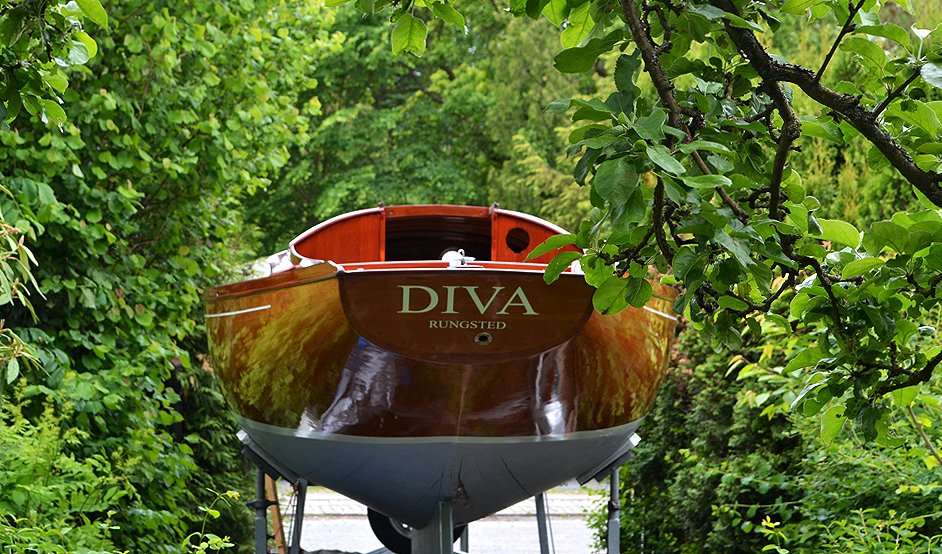2011 // 2012
Condition at time of purchase
The boat was located on a private property in Vedbaek (town in Zealand), and I decided to purchase it after the first viewing, which lasted about 10 minutes.
We transported the boat on a trailer to my address in Holte (town in Zealand), where I worked on it throughout the winter. The previous owner, Lars G., kindly allowed us to borrow the trailer for the winter.
The overall condition of OD 61 was fundamentally good. The freeboard was in great shape. The deck had been replaced with plywood and was in perfect condition. However, the hull had cracks in several places, and there was some rot spotted in a few planks below the waterline. The paint on the superstructure needed some attention. The canvas on the cabin was not watertight either. The railing was worn and had a few visible screw heads. There were also 13 broken ribs/frames. The mast's varnish needed to be thoroughly renewed.
We now have a Knarr from 1968. Not just any Knarr. We can sense its history. The goal is set. DIVA is to be brought back to an excellent condition aiming to preserve the feeling of its history and excellence.
-
Cabin Roof - Canvas or Not?
The cabin roof was covered with painted canvas, which unfortunately had become worn and leaky. Water had penetrated into the front cabin corners and had loosened a corner stopple, which was reattached with epoxy.
I chose to varnish the cabin roof with white Coelan varnish, which is a highly flexible varnish that can adapt as the wood either contracts or expands accordingly. -
Old varnish removed.
Cockpit, cockpit coaming, caulking, cabin roof, and partially inside.
The boat was stripped of varnish and sanded until a consistent color appears in the mahogany. It takes more sanding than one might initially anticipate achieving a uniform color in the wood.
-
Mast - Complete Renovation.
The Oregon pine mast is the originally fitted.
All fittings were removed, inspected, and polished. The varnish was burned and scraped off, and the mast was sanded and prepared for varnishing. This was an extensive process with multiple steps.
The mast was varnished with the flexible Coelan varnish. -
New Parts.
Not everything can be salvaged.
If parts of a boat can be renovated, I prefer to renovate them rather than replacing them with new ones.
I also crafted a new tiller, the struts and the two spreaders.The running rigging was completely replaced.
Additionally, the deck - both inside and outside - was glued together where it had cracked and sanded down to its base. In the cabin, the mahogany deck was oiled. The deck could still be used as it was, but it had not escaped the tests of time, and there was a future project waiting here. The same could be said for the teak deck in the cockpit.
Varnishing with Coelan Varnish
There are pros and cons to use the Coelan varnish. My experiences with Coelan varnish have been mostly positive, and I would recommend it, though not for all varnishing work.
The varnish has a beautiful shine. It is highly elastic. Hard impacts may leave an indentation in the wood, but the varnish remains intact. It does not crack. Furthermore, the varnish has long durability (recoating every 6-8 years) and is vapor-permeable. Many coats can be applied in one day without the need for intermediate sanding (depending on temperature and humidity).
As for the drawbacks, I can mention that it's challenging to achieve a perfectly smooth finish, especially on vertical surfaces (orange peel effect). It can be difficult to apply with precision and it is tough to sand as well.
I have used Coelan varnish on all surfaces, except for the topsides and inside the cabin.
You can purchase the varnish from Hellers in Denmark, providing excellent guidance from Peter Heller.
Completed Work, Spring 2012
Below, you can see the result of the finished work. It's always satisfying. The entire superstructure was renovated and is watertight. Replacing the railing will be a future project for the moment. The hull, which had cracks and some minor rot in a few planks, was repaired temporarily. The boat needs to be put in the water and we'll see how much it tightens up. After all, it had been on dryland for quite some time.











